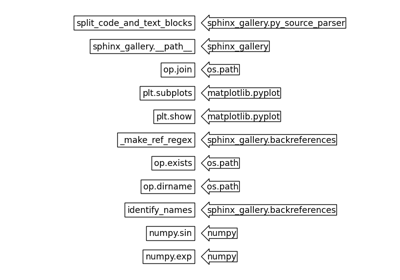sphinx_gallery.backreferences#
反向引用生成器。
解析示例文件代码以跟踪使用的函数。
函数#
- sphinx_gallery.backreferences.identify_names(script_blocks, ref_regex, global_variables=None, node='')[source]#
通过识别和解析使用的名称来构建 codeobj 摘要。
- 参数:
script_blocks (list) – (label, content, line_number) 列表,其中每个元素都是一个包含标签(‘text’ 或 ‘code’)、对应块的内容字符串和前导行号的元组。
ref_regex (str) – 用于查找 Python 对象引用的正则表达式。
example_globals (Optional[Dict[str, Any]]) – 示例的全局变量。默认值=None
node (ast.Module or str) – 解析的节点。默认值=””。
- 返回:
example_code_obj – 包含示例中找到的所有代码对象引用的信息的字典。字典包含以下键
example_code_obj[‘name’] : 函数或类名 (str)
example_code_obj[‘module’] : 模块名 (str)
example_code_obj[‘module_short’] : 简化的模块名 (str)
example_code_obj[‘is_class’] : 对象是否为类 (bool)
- example_code_obj[‘is_explicit’]对象是否为显式
反向引用(由 Sphinx 标记引用) (bool)
- 返回类型:
Dict[str, Any]
使用 sphinx_gallery.backreferences.identify_names 的示例#
类#
- class sphinx_gallery.backreferences.NameFinder(global_variables=None)[source]#
查找代码中变量名的最长形式及其导入。
仅保留来自导入模块的名称。
